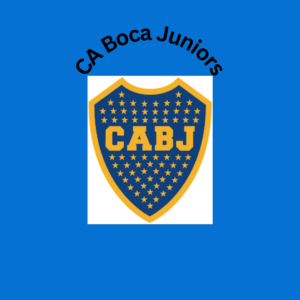History of Atlético Boca Juniors FC
The history of Atlético Boca Juniors FC – Club Atlético Boca Juniors, one of the most iconic football clubs in Argentina and the world, was founded on April 3, 1905, in the working-class neighborhood of La Boca in Buenos Aires. The club’s creation was initiated by a group of young Italian immigrants who shared a passion for football, a sport that was rapidly spreading in Argentina at the time.
The five founders, Esteban Baglietto, Alfredo Scarpatti, Santiago Sana, and brothers Juan and Teodoro Farenga, held their first meeting on a bench in Plaza Solís, a small park in La Boca. Inspired by their shared heritage and the vibrant community of La Boca, they decided to form a football club that would represent the neighborhood’s identity and immigrant roots.

Initially, the team played friendly matches against other local clubs and did not have a fixed kit. The club’s colors were chosen after a legendary decision in 1907: Boca Juniors would adopt the colors of the flag of the next ship to enter the port of Buenos Aires. A Swedish ship arrived, and its blue and yellow flag inspired Boca Juniors’ now-famous colors. The team adopted a blue jersey with a yellow stripe, a design that has become one of the most iconic in world football.
In its early years, Boca Juniors participated in lower divisions, facing rivals from Buenos Aires and its outskirts. The club quickly gained popularity for its tenacity on the field and its passionate fanbase, which resonated with the working-class ethos of La Boca. Boca was promoted to Argentina’s top division in 1913, marking the beginning of its rise to prominence.
Boca Juniors moved into their iconic stadium, La Bombonera, in 1940. Officially named Estadio Alberto J. Armando, the venue became known for its steep stands, unique acoustics, and the raucous atmosphere created by Boca’s fans, famously known as “La Doce” (The Twelfth Man).
Boca’s competitive success began early, and by the 1920s, the club had established itself as one of Argentina’s strongest teams. Over the decades, Boca Juniors became synonymous with Argentine football, winning numerous domestic and international titles, including multiple Copa Libertadores championships.
Today, Boca Juniors is celebrated worldwide for its rich history, passionate supporters, and status as one of the most successful and culturally significant football clubs in history.

10 interesting facts about Atlético Boca Juniors FC
- The Origin of the Name “Boca Juniors”
The club’s name reflects its origins in the La Boca neighborhood of Buenos Aires, but the addition of “Juniors” was meant to give it an English flair, as football was introduced to Argentina by British immigrants and sailors. The founders felt this would make the club’s name more sophisticated. - The Swedish Flag’s Role in the Club’s Colors
Boca Juniors’ iconic blue and yellow colors were chosen in 1907 after the founders decided to adopt the colors of the flag of the next ship to dock at the port. The ship happened to be Swedish, and its flag inspired the now-famous kit. - A Rivalry Born from Shared Roots
Boca Juniors and their fiercest rivals, River Plate, were both founded in the same neighborhood, La Boca. River Plate later relocated to Núñez, but the shared roots of the two clubs make the Superclásico one of the most intense rivalries in world football. - La Bombonera’s Unique Acoustics
Boca Juniors’ iconic stadium, La Bombonera, is famous for its steep stands and compact design. The unique acoustics amplify the crowd’s noise, making it one of the loudest stadiums in the world. Fans say the stadium literally “shakes” during games due to the energy and vibrations. - Unbeaten International Record in Japan
Boca Juniors has a stellar international record, particularly in Japan, where they have played several successful Intercontinental Cup finals, defeating European giants like Real Madrid (2000) and AC Milan (2003). - A Youth Academy That Shaped Legends
Boca Juniors’ youth academy, La Candela, has produced some of the most iconic players in football history, including Diego Maradona, Juan Román Riquelme, Carlos Tevez, and Fernando Gago. It is regarded as one of the best talent factories in the world. - Diego Maradona’s Eternal Legacy
Diego Maradona, one of the greatest footballers of all time, is synonymous with Boca Juniors. Despite playing for the club only briefly in his prime, his emotional connection to Boca made him a lifelong fan and symbol of the club’s ethos. - The Global Reach of Boca’s Fans
Boca Juniors’ fan base extends far beyond Argentina, with supporters’ clubs in over 50 countries. Its international reach makes Boca one of the most popular and recognized teams globally. - First Argentine Club to Reach 70 Titles
Boca Juniors was the first Argentine club to achieve the milestone of 70 official titles, showcasing its consistent dominance in domestic and international football. - The Myth of “La Doce”
Boca Juniors’ fan group, known as “La Doce” (The Twelfth Man), is one of the most passionate and organized in the football world. Their synchronized chants, banners, and presence are legendary, often intimidating opponents.
Boca Juniors’ combination of cultural heritage, fierce rivalry, and footballing success makes it one of the most fascinating and celebrated clubs in the world.

Hey there! Do you know if they make any plugins to safeguard against hackers? I’m kinda paranoid about losing everything I’ve worked hard on. Any recommendations?
I found your blog site on google and examine just a few of your early posts. Proceed to keep up the excellent operate. I simply further up your RSS feed to my MSN Information Reader. Seeking ahead to studying more from you afterward!…